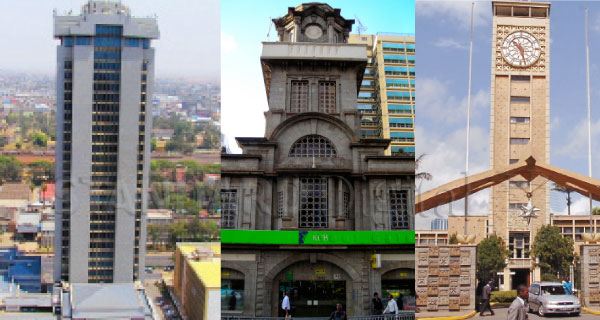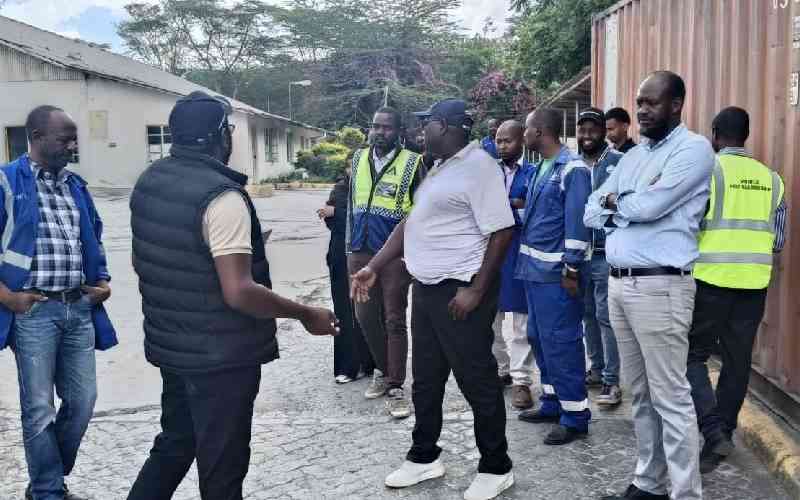 |
|
KICC and Parliament buildings are easily recognisable around the world. FACING PAGE: Times Tower. [PHOTOS: FILE/STANDARD] |
By PETER MUIRURI
For the last 50 years, Kenya has witnessed a transformation in the construction sector with modern structures dotting the landscape. Local architects have been in the forefront in designing some of the country’s landmark structures that compete for attention with the world’s best.
For example, Triad Architects, one of the country’s oldest architectural firms, is behind a number of Nairobi’s iconic buildings. Incorporated in 1963 by Amyas Douglas Connell and Graham McCullough, founder of The Professional Centre, Triad has designed more than 1,000 projects since inception.
Below are some of Nairobi’s well-known structures and the people behind the designs.
Parliament Buildings
As Kenya’s independence approached, there was a need for modern legislative chambers. In 1951, Amyas Douglas Connell was invited by the British authorities to work on Parliament. But having Connell work on the project was a contradiction of sorts considering that his previous experience with the British government was quite stormy.
Back home, Connell had come up with certain designs for local projects that rubbed British authorities the wrong way. Dubbed the “rebel architect” by Charles Hayes in an article published by The Standard in May 1980, a number of Connell’s works were said to be “unBritish, French influenced and German oriented.” Connell refused to back down and some of his works have become the most cherished in British architecture.
Interestingly, the British colonial masters wanted a replication of the palaces of Westminster in the new Kenyan Parliament. Connell acceded to this request by adding the iconic clock tower, a small version of London’s Big Ben Clock Tower. The first wing opened in 1954.
The second phase that included the artistic protrusion on the southern wing was added several years later and was ready when Kenya gained independence in 1963. Other buildings bearing Connell’s personal touch are the Aga Khan Hospital and Sheria House.
KICC
Few buildings inspire awe and respect like KICC. Ever since it was built in the early 1970s, KICC continues to be one of the most iconic buildings in the country.
Like the Statue of Liberty in New York City or the London Bridge, the edifice whose design is weaved around the African traditional hut is arguably Nairobi’s main reference point having featured in almost every postcard and local postage stamps.
Hordes of street photographers have made the building their perfect backdrop as pose for the city’s iconic image. But did you know the brains behind this architectural masterpiece?
Two names that feature prominently are those of architect David Mutiso, the first African member of the Architectural Association of Kenya and Karl Henrik Nøstvik. Mutiso was also the first African chief architect at the Ministry of Public Works.
According to Buildesign magazine, the then Kanu Secretary General Tom Mboya, informed Mutiso in 1968, that Kanu intended to erect a building to house the independence party.
Stay informed. Subscribe to our newsletter
The two men worked together to come up with designs that were discussed with the party’s top brass including President Jomo Kenyatta on a weekly basis. This resulted in laying the foundation stone by the president in December 1967. It was opened on September 11, 1973.
The 30-storey building was designed with a restaurant at the topmost level that revolves every 55 minutes, giving patrons various views of the city. Mounts Kenya and Kilimanjaro are visible from atop the building on clear days. It is also the first building in the city to have a helipad at the top.
For decades, the building housed the independence party with President Daniel Moi being a regular guest to the building. When Mwai Kibaki took over as president, KICC was wrestled from Kanu and is now a government facility housing many international organisations. Interestingly, Kibaki was the Finance minister during the construction phase.
Times Tower
Triad, the firm that Connell founded, is behind the design of Times Tower, also known as the New Central Bank Tower. At 38 floors, it is East and Central Africa’s tallest building. Despite its height, it is one of the sturdiest structures with the ability to withstand earthquakes.
Coca-cola Plaza
Located in Nairobi’s fast growing Upper Hill district, Coca-cola Plaza is yet another brainchild of Triad Architects in collaboration with GAPP Architects and Urban Designers of South Africa. Completed in August 2008, the building is the regional head office for the giant firm, supervising activities in 27 countries in Africa.
Viewed from above, the shape of the building forms the letter ‘C’, synonymous with the company’s logo.
Built at a cost of $10 million (Sh870 million), the building is said to be one of the greenest in the region. It has wide, clear windows with a north/south orientation to allow natural lighting to filter in while keeping direct heat away from the building and eliminating the need for mechanical air conditioning system.
Rainwater harvesting techniques with a capacity to hold 50,000 litres of water have been included, while a rooftop lawn reduces heat gain, further making the building cooler most of the day.
Kipande House
When Gurdit Singh designed Kipande House early on in the last century, in 1913, it was the tallest building in Nairobi. The fancy building with a peculiar tower was the place where Africans were supposed to be registered and issued with identification documents.
In 2006, Kenya Commercial Bank commissioned Triad Architects to undertake internal refurbishment of the building by creating a large banking hall while KCB architect Derek Fialt worked on the exterior, retaining the vintage look.
Owing to its rich history, the former labour office was gazetted as a national monument and the bank was only allowed to use it as long as there were no structural alterations.
“Before we allow the bank to put it to use, we had to make sure its structure would not be affected by any renovations,” said the then director of Kenya National Archives Dr Maina Kagombe.
 The Standard Group Plc is a
multi-media organization with investments in media platforms spanning newspaper
print operations, television, radio broadcasting, digital and online services. The
Standard Group is recognized as a leading multi-media house in Kenya with a key
influence in matters of national and international interest.
The Standard Group Plc is a
multi-media organization with investments in media platforms spanning newspaper
print operations, television, radio broadcasting, digital and online services. The
Standard Group is recognized as a leading multi-media house in Kenya with a key
influence in matters of national and international interest.
 The Standard Group Plc is a
multi-media organization with investments in media platforms spanning newspaper
print operations, television, radio broadcasting, digital and online services. The
Standard Group is recognized as a leading multi-media house in Kenya with a key
influence in matters of national and international interest.
The Standard Group Plc is a
multi-media organization with investments in media platforms spanning newspaper
print operations, television, radio broadcasting, digital and online services. The
Standard Group is recognized as a leading multi-media house in Kenya with a key
influence in matters of national and international interest.










